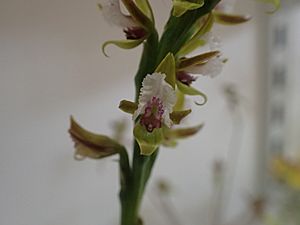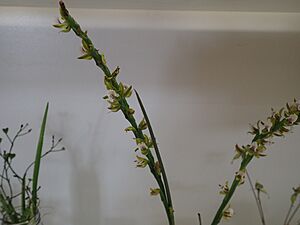Fringed leek orchid facts for kids
Quick facts for kids Fringed leek orchid |
|
|---|---|
 |
|
| Prasophyllum fimbria at the Ravensthorpe Wildflower Show | |
| Scientific classification |
The Prasophyllum fimbria, also known as the fringed leek orchid, is a special type of orchid. It is only found in the south-west part of Western Australia. This orchid is quite tall. It has one smooth, tube-shaped leaf. It can grow up to seventy greenish-brown flowers. These flowers have a white and pink part called a labellum, which is like a lip.
Contents
What Does It Look Like?
The fringed leek orchid is a plant that grows from the ground. It is a perennial herb, which means it lives for more than two years. It also has an underground tuber, which is like a storage root. The plant has a single smooth leaf shaped like a tube. This leaf can be about 20 to 80 centimeters (8 to 31 inches) long. It is about 5 to 10 millimeters (0.2 to 0.4 inches) wide near its base.
Flowers and Their Features
This orchid grows a tall flowering stem, or spike. This spike can be 6 to 20 centimeters (2.4 to 7.9 inches) high. It can be green or almost black. Each plant can have seventy or more flowers on this spike. The flowers are greenish-brown. They are about 18 millimeters (0.7 inches) long and 9 to 10 millimeters (0.35 to 0.39 inches) wide.
Like other orchids in its group, the flowers of the fringed leek orchid are upside down. This means the labellum (the lip-like part) is at the top instead of the bottom. The dorsal sepal is the lowest part of the flower. The petals point forward. The lateral sepals stand upright and are joined together.
The labellum is white and curves upwards. It has a frilly edge, which is why it's called the "fringed" leek orchid. In the middle of the labellum, there is a frilly, pinkish part called a callus.
When Does It Flower?
The fringed leek orchid blooms from June to September. It flowers much more after a bushfire happened the summer before.
Where Does It Grow?
The fringed leek orchid can be found in many different places. It grows in wet areas like swamps. It also grows in open areas like heathlands and in woodlands. You can find it from Kalbarri in the north all the way to Esperance in the east.
Conservation Status
The Western Australian Government's Department of Parks and Wildlife says that this orchid is "not threatened." This means it is not currently in danger of disappearing.


